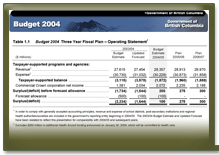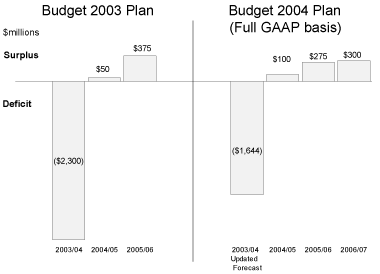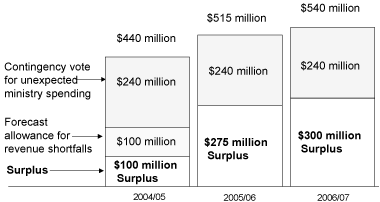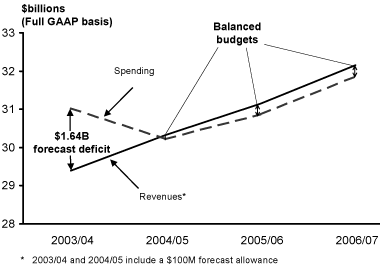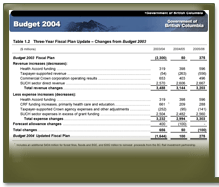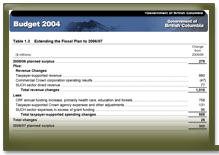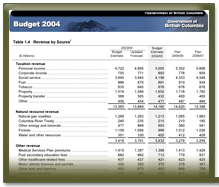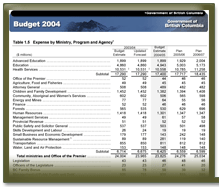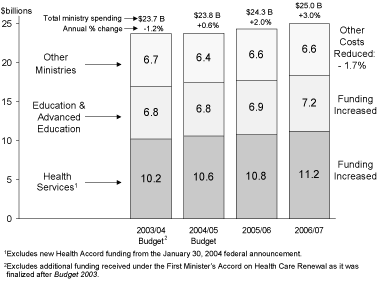 |
|
Part 1: THREE-YEAR FISCAL PLAN
IntroductionBudget 2004 delivers on government's legislated commitment to balance the budget beginning in 2004/05. The updated fiscal plan projects surpluses for 2004/05 and the following two fiscal years. A $100 million surplus is forecast in 2004/05, followed by $275 million and $300 million surpluses in 2005/06 and 2006/07 respectively. The three-year fiscal plan conforms to the standards set by the accounting profession for senior governments in Canada referred to as generally accepted accounting principles or "GAAP". The main change required to fully comply with GAAP in 2004/05 has been to integrate the financial forecasts of schools, universities, colleges and health authorities/societies (the SUCH sector) into government's revenue, spending and balance sheet projections. For comparability with the three-year fiscal plan for 2004/05 to 2006/07, the Budget 2004 fiscal plan includes restatements of the 2003/04 budget and forecast to include the SUCH sector. As shown in Table 1.1, the 2003/04 forecast deficit – restated to include the SUCH sector – is $1,644 million, $590 million less than the $2,234 million restated budget deficit. On the Budget 2003 basis that excludes the SUCH sector, the updated 2003/04 deficit forecast is $1,710 million. The effect of including the SUCH sector in 2003/04 is to reduce the deficit forecast by an estimated $66 million. For information on the updated 2003/04 forecast and changes since the February 18, 2003 budget, see Part 4: 2003/04 Updated Financial Forecast (third Quarterly Report). Chart 1.1 Updated Balanced Budget Plan
Over and above the $100 million forecast surplus, the 2004/05 budget includes a $240 million contingency vote for unexpected spending requirements by government ministries. A further $100 million forecast allowance is available to protect the bottom line from shortfalls in revenue, Crown corporation income and other areas. When combined with the $100 million surplus, these provide a $440 million cushion to protect the balanced budget plan against unforeseen events in 2004/05. A $240 million contingency vote is also assumed in each of 2005/06 and 2006/07. Combined with the forecast surpluses, the total cushion protecting the balanced budget against economic, revenue and other forecast shocks is $515 million in 2005/06 and $540 million in 2006/07. The three year fiscal plan is based on the Ministry of Finance economic forecast that projects economic growth of 2.8 per cent for 2004 and 3.1 per cent in 2005 and 2006, slightly less than the independent Economic Forecast Council consensus. Full details of the economic forecast are found in Part 3: British Columbia Economic Review and Outlook. Chart 1.2 Provisions to Protect the Balanced Budget Plan
In turn, the revenue forecast is based on income growth, commodity prices, the exchange rate and other related assumptions included in the economic forecast. Revenue also includes forecasts submitted by Crown corporations and organizations in the SUCH sector. The resulting total revenue forecast projects an annual growth rate of 3.2 per cent in 2004/05, led by growing revenues from taxation sources. In 2005/06 and 2006/07, revenue is forecast to grow an average 2.8 per cent per year. The spending plan is based on government's review of ministry spending plans and allocation or reallocation of available financial resources to meet government priorities. The plan is centered on the Consolidated Revenue Fund (CRF) that makes up over 80 per cent of total government spending. The remainder includes the spending of taxpayer-supported Crown corporations and agencies and SUCH sector organizations, net of grants paid to those entities from the CRF. Overall spending is forecast to decline by 2.6 per cent between 2003/04 and 2004/05, as government spending is brought in line with available revenues in order to achieve a balanced budget. For 2005/06 and 2006/07, spending is planned to grow an average 2.7 per cent per year. With planned balanced budgets, additional economic and revenue growth provides the basis for expanded service levels, lower tax rates and/or debt repayment. The need to ensure robust revenue growth to provide these choices underscores the priority placed on building a strong and vibrant economy in British Columbia. Since Budget 2003, government has committed new revenues and savings from other areas to the priority areas of health care and education. Additional funding has also been provided for services to children and vulnerable adults, and income assistance for people in need. Chart 1.3 Spending Plan Aligned With Revenues
Budget 2004 updates the three-year fiscal plan tabled on February 18, 2003, and extends the plan to 2006/07. Table 1.2 summarizes the developments to the fiscal plan since the plan was tabled in February 2003. Over the three years, taxpayer-supported revenues are lower than previously forecast mainly due to lower forest and equalization revenues. These reductions are more than offset by increases to commercial Crown corporation net income forecasts, primarily BC Hydro and the Liquor Distribution Branch in 2004/05 and 2005/06. For Budget 2004, revenues have been augmented by the direct revenues of the SUCH sector, which include post-secondary fees, federal contributions to SUCH entities, their own investment earnings and various miscellaneous revenues. The revenue forecast is described starting on page 31, and revenue policy changes are detailed in Part 2: Revenue Measures.
Spending changes are based on the review and allocation of resources to ministry budgets in the CRF, together with updates to taxpayer-supported Crown corporation forecasts and SUCH sector spending forecasts, net of grants received from government. Further information on the spending forecast, including the CRF spending plan, is found below. A description of the SUCH sector and the impact of its inclusion into the government budget framework is provided in the "Inclusion of SUCH in the Government's Budget and Reporting Framework" topic box at the end of Part 1. For 2006/07, an annual revenue increase of $1.01 billion is forecast. This allows for additional CRF funding commitments of $758 million, primarily for health care, education and forestry development. As shown in Table 1.3, the annual revenue increase also accommodates growth in net spending of taxpayer-supported Crown corporations and agencies, and SUCH organizations, while maintaining a planned surplus of $300 million. BC's estimated $260 million share of the additional $2 billion federal Health Accord funding announced on January 30, 2004 is not included in Budget 2004. However, all of those funds will be added to the health care budget once details of the January 30 federal plan are known and the appropriate accounting treatment is confirmed. Government debt at the end of 2003/04 is forecast to total $37.8 billion, $3.6 billion less than budget. This results from a lower than expected deficit, lower debt at the start of the year, reduced capital spending, and defeasance of BC Rail's debt. Lower debt interest costs in 2004/05 and future years result from the reduced borrowing requirements. The taxpayer-supported debt-to-GDP ratio is forecast to show a declining trend in future years as planned surpluses start to reduce future borrowing requirements. Additional information on the debt outlook is found starting on page 42. The main risks to the government fiscal plan include economic fluctuations such as exchange rate or commodity price shocks, and equalization changes on the revenue side, as well as wage and service demand pressures on the expenditure side. These and other risks are more fully described starting on page 44. Consistent with government's accountability framework, the budget and three-year fiscal plan is complemented by the service plans for government ministries and Crown corporations that detail their goals, objectives and performance targets. Ministers and ministers of state are also subject to ministerial salary deductions if financial or performance targets are not achieved.
|
||||||||||||||||||||||||||||||||||||||||||||||||||||||||||||||||||||||||||||||||||||||||||||||||||||||||||||||||||||||||||||||||||||||||||||||||||||||||||||||||||||||||||||||||||||||||||||||||||||||||||||||||||||||||||
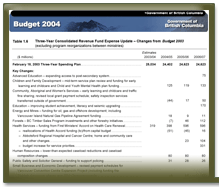 |
Table 1.6 Three-Year Consolidated Revenue Fund Expense Update – Changes from Budget 2003 | ||
Health Care
Budget 2004 invests growing provincial revenues in British Columbia's priorities such as health care while keeping services affordable. Over the next three years, health care will receive the largest share of funding increases.
Chart 1.6 Health Care Budget Change
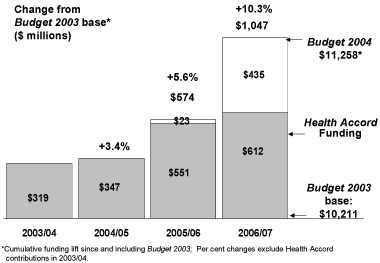
By 2006/07, the Health Services budget will increase by over 10 per cent or $1 billion since Budget 2003 was delivered on February 18, 2003. This reflects the government's commitment to reinvest every dollar from the First Ministers' Accord on Health Care Renewal funding (finalized later in 2003/04) and new provincial health funding added in 2005/06 and 2006/07 for priority areas.
Health Accord funding is being used to help ensure that Fair Pharmacare remains affordable, to provide vital diagnostic and medical equipment funding to health authorities, new vaccination programs for children and increased patient care. A portion of Health Accord equipment funding is also being spent through the capital spending budget rather than the operating budget.
On January 30, 2004, the federal government fulfilled a Health Accord commitment by announcing that additional new health funding of $2 billion would be made available to provinces. British Columbia's share is estimated at $260 million. Current plans would see the funds allocated evenly with $130 million being spent in 2004/05 and another $130 million used in 2005/06. These incremental funds would be used for acute and post-acute home and community care to free up hospital beds; community-based mental health designed to prevent hospital admissions; critical care pharmaceuticals and services; increased capacity for Nurseline/Bedline to provide better services; and increased surgical capacity to address waitlists.
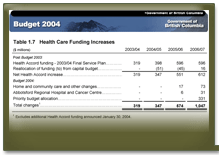 |
Table 1.7 Health Care Funding Increases | ||
At the time of preparing Budget 2004, the federal government had not yet confirmed the exact amount of its new funding for health care. Once the federal government confirms the new health funding and appropriate accounting has been finalized, a Supplementary Estimate will be presented to the Legislature.
Funding has been added to the Health Services budget in 2005/06 and 2006/07 to begin early planning and preparation for the new Abbotsford Regional Hospital and Cancer Centre and for additional support to home and community care clients. A further $331 million is being allocated in 2006/07 to help address anticipated price and volume increases in Fair Pharmacare, significantly increase home and community care services, increase funding for critical pharmaceuticals and services such as renal dialysis, cancer, and HIV/AIDs, and for additional surgeries.
Health Services will provide $694 million in capital funding (including funding from the Health Accord) for new construction, equipment and upgrading of existing health facilities over the next three years. In addition, government-owned Crown land with an estimated value of $121 million, upon which the BC Children's Hospital and BC Women's Hospital and Health Centre is situated, will be transferred to the Provincial Health Services Authority.
Provincial capital funding will support priority initiatives including Riverview Hospital replacement projects, home and community care facility projects, medical and diagnostic equipment, academic space projects related to the UBC medical school expansion and rehabilitation of existing health facilities throughout the province.
Chart 1.7 Health Capital Spending
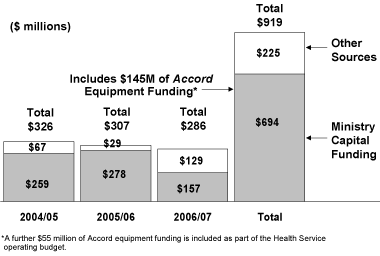
Health Authorities will also spend a further $225 million for minor capital purchases (such as beds and lifts) and capital projects, financed through operating grants provided by the Ministry of Health Services as well as through own-source revenues. Table 1.17 provides information on provincially funded projects of $50 million or more. More information on capital spending is provided in the Ministry of Health Services 2004/05 – 2006/07 Service Plan.
Education – K-12
Budget 2004 invests growing provincial revenues to improve student achievement in public schools, promote literacy in communities and make schools safer.
Chart 1.8 K-12 Education Budget Change
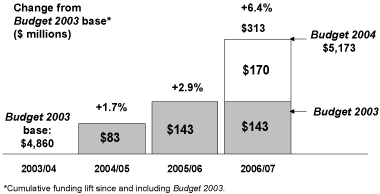
Over the next three years, the K-12 education budget will increase by more than $300 million to help support improved student achievement and make schools safer.
While student enrolment in public schools has been declining, overall funding per student in 2003/04 has risen by $313 since 2000/01. Spending per pupil in 2004/05 will increase $219 from 2003/04 and by a further $107 in 2005/06. Details on per pupil spending in 2006/07 will be provided at a later date.
Chart 1.9 Student Enrolment and Per Pupil Funding (Public Schools)
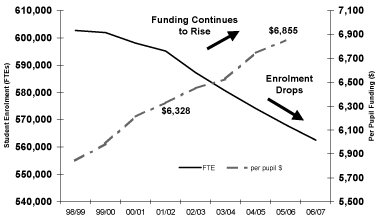
Additional funding will be used to help achieve:
- High school completion rates reaching 85 per cent within five years.
- 90 per cent of students meeting expectations for reading by the end of the third grade.
- School completion rates for aboriginal students equaling those of all students, with significant progress made each year – the completion rate for aboriginal students has risen from 42 per cent in 2001/02 to 46 per cent in 2002/03.
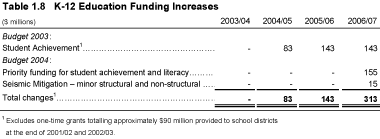
Literacy will also be a focus of education, and initiatives will include an early literacy success strategy targeted at students in the first years of school, and a program to improve literacy in schools, the workplace and communities.
Over the next three years, operating spending for non-structural and minor structural seismic upgrades to schools will be increased from $8 million to $23 million by 2006/07 as part of a province-wide review of seismic upgrade needs. Based on results of the review, a further $50 million per year in capital spending will also be earmarked for major structural seismic upgrading beginning in 2006/07.
The Ministry of Education will provide school districts with $442 million in capital funding to support new construction and upgrading of existing K-12 facilities including seismic upgrading. In addition, $182 million will be spent by school districts for minor capital projects funded in part through operating funds provided by the ministry. Further information on capital spending is provided in the Ministry of Education's 2004/05 – 2006/07 Service Plan.
Chart 1.10 K-12 Education Capital Spending
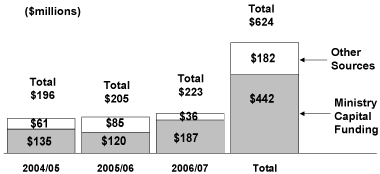
Post-Secondary Education
Budget 2004 is about investing growing provincial revenues to increase access to higher education.
Chart 1.11 Post-Secondary Education Budget Change
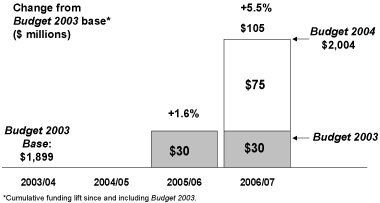
Funding for post-secondary education will increase $105 million over the next three years to improve student access to higher education in communities across the province.
In partnership with the post-secondary sector, 11,811 new student FTE spaces will be created over the next three years and more than 25,000 spaces by 2009/10. As a result, overall seat growth will be 2 per cent in 2004/05, rising to 2.6 per cent in 2005/06 and 2006/07 – approximately double the estimated population growth for the 18-29 age group.
Chart 1.12 Post-Secondary Student FTE Spaces
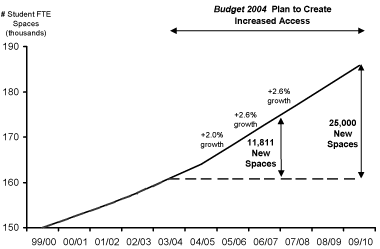
The goal of expanding access while providing financial support to students has required some changes to funding arrangements. Effective August 2004, funding of student grants will be replaced with an expanded student loan program. Funds from this change will be reinvested to create more student spaces starting in 2004/05. Students who require financial assistance will still have access to the same level of funding to pursue their education.
Taxpayers will continue to fund 70 to 80 per cent of the cost of every seat for domestic students at the 27 public colleges, university colleges, universities and institutes. Over 50 per cent of BC university students graduated debt free based on a 2002 report of university graduates who completed studies in 2000. The government expects that this trend will continue.
The Ministry of Advanced Education will be working to adjust its programs to assist those students most in need and determine how best to harmonize its student aid programs with the recently-announced federal changes in this area. Alternatives under consideration over the next three years include completion grants and loan remissions.
The government anticipates that new funding over the next three years will not only provide for expanded seats, but an opportunity for post-secondary institutions to mitigate tuition fee increases.
The Ministry of Advanced Education will provide post-secondary institutions with $665 million in capital funding to support new construction and upgrading of existing facilities. This amount includes $30 million toward the provincial contributions to the cost of 2010 Olympic venues that would be owned by post-secondary institutions.
Capital funding provided by the ministry will support various projects including the UBC Life Sciences Centre, the Northern Medical facility at UNBC, the Island Medical facility at the University of Victoria, BC Knowledge Development Fund projects, as well as the rehabilitation, replacement and expansion of existing post-secondary facilities throughout the province.
Post-secondary institutions will spend a further $313 million for other projects from their other own-source revenues.
Chart 1.13 Post-Secondary Education Sector Capital Spending
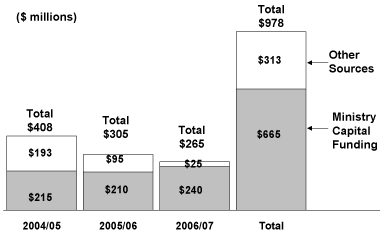
Further announcements on new projects and access initiatives will be made in the coming months.
Table 1.17 provides information on provincially funded projects of $50 million or more. Further information on capital spending is provided in the Ministry of Advanced Education's 2004/05 – 2006/07 Service Plan.
Communities and Safety
Budget 2004 invests growing provincial revenues to help people find employment; protect vulnerable children and families, and adults with developmental disabilities; increase access to early learning and childcare programs; and protect communities from crime.
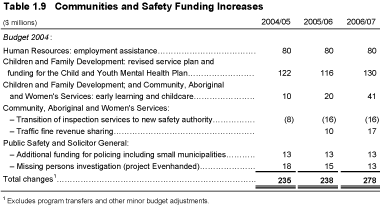
An additional $80 million per year has been provided to the Ministry of Human Resources as a result of a lower than assumed rate of decline in the caseload and changes in its composition.
While the caseload has declined significantly over the last two years, due to successful strategies to help clients find employment, the rate of decline has slowed. Since 2001/02, the expected-to-work caseload has fallen from 84,114 to 33,140 in 2003/04, a decline of 50,974 or 61 per cent. Over the next three years, this caseload is forecast to decline to 20,200, a further decrease of 12,940 or 39 per cent. Since June 2001, more than 26,000 income assistance clients have been placed in jobs through ministry-sponsored programs. Further information on caseloads is provided in a topic box at the end of this chapter.
Following a mid-term service plan review in June 2003, the three-year budget for the Ministry of Children and Family Development was increased to protect the health and safety of vulnerable children and families, and adults with developmental disabilities. Over the next three years, the ministry will continue its transition to establishing new governance authorities. In 2006/07, $14 million has been added to the budget to support the Child and Youth Mental Health Plan.
Over the next three years, over $70 million in new funding is provided to the ministries of Children and Family Development and Community, Aboriginal and Women's Services to increase family access to early learning and childcare programs.
As part of the Core Review announced previously, safety inspection services in the Ministry of Community, Aboriginal and Women's Services will be assumed by an independent self-financed safety authority in 2004/05.
Starting in 2005/06, Budget 2004 includes additional funding to phase in traffic fine revenue sharing with local governments. The traffic fine initiative will fulfill a New Era commitment.
Budget 2004 includes additional funding for the Ministry of Public Safety and Solicitor General in recognition of the growing need for protection of communities and to continue with priority police investigations. Funding for policing has increased since 2001/02, resulting in additional provincial police resources focused on organized crime, major criminal investigations, illegal gaming and traffic enforcement.
As in each year since 1998, funding for the BC Family Bonus will be reduced in response to federal increases to the National Child Benefit Supplement. However, depending on family circumstances, families will receive the same or increased combined federal and provincial benefits. Further information is provided in Part 2: Revenue Measures.
Economy and Natural Resources
Budget 2004 invests growing provincial revenues to revitalize the economy and maximize provincial benefits from natural resources.
Vancouver Convention Centre Expansion Project (VCCEP)
In December 2003, Tourism Vancouver confirmed its $90 million contribution to the VCCEP. The province and the federal government had each previously committed $202.5 million to the VCCEP, bringing total funding commitments to $495 million. The provincial and federal governments have also committed an additional $20 million each to upgrade and link the existing Vancouver Convention and Exhibition Centre to VCCEP (the Integration Project). The province has also committed an additional $7.5 million to the Integration Project, subject to the federal government matching this amount. This brings the total provincial commitment for the VCCEP and the Integration Project to $230 million.
Budget 2004 provides for $163 million in provincial contributions to the VCCEP and the Integration Project. Combined with the 2003/04 provincial contribution of $67 million, the provincial funding commitment will be fulfilled in 2006/07.
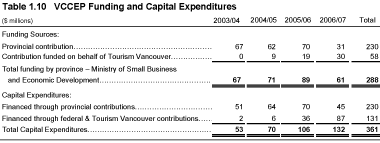
The province will also fund the $90 million Tourism Vancouver contribution to the VCCEP, including $58 million from 2004/05 to 2006/07. Tourism Vancouver will use its own revenue sources to reimburse the province for funding its $90 million contribution.
All contributions provided on behalf of the province and Tourism Vancouver are funded through the Ministry of Small Business and Economic Development to VCCEP Ltd.
In the government's financial statements, contributions provided by the province to VCCEP Ltd. are eliminated to prevent double counting of actual spending. Projected capital spending by VCCEP Ltd. includes capital expenditures funded by the province, federal government and Tourism Vancouver contributions, plus interest costs during construction (Table 1.16). The provincial share of capital spending for VCCEP Ltd. is also shown on Table 1.17.
2010 Olympic and Paralympic Winter Games (2010 Olympics)
In July 2003, Vancouver was selected as the host city of the 2010 Olympics. As part of honouring the provincial funding commitment to the 2010 Olympics, Budget 2004 provides for a total investment of $235 million from 2003/04 to 2006/07, including:
- $162 million in operating and capital grants toward the construction cost of venues – representing 64 per cent of the provincial commitment for venues;
- $55 million in grants for an endowment to support the ongoing operation of certain venues – representing 100 per cent of the provincial commitment for the endowment;
- $3 million in funding for medical and security planning; and
- $15 million in funding for First Nations and municipal legacies.
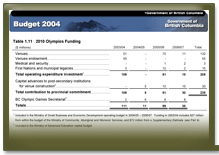 |
Table 1.11 2010 Olympics Funding | ||
Of the $235 million investment, $205 million is included as part of government spending. An additional $30 million will be provided as capital advances to post-secondary-institutions through the Ministry of Advanced Education in support of the 2010 Olympics venues constructed and owned by the institutions.
In addition, the Ministry of Small Business and Economic Development budget includes funding to support the BC Olympic Games Secretariat for coordination and provincial oversight activities.
Lower debt interest costs in 2003/04 have created room to accelerate the funding of the provincial commitment to the 2010 Olympics. As a result, $37 million will be provided in 2003/04 through the existing budget and $72 million through a Supplementary Estimate funded from savings achieved through lower debt interest.
Transportation Investment Plan
Budget 2004 updates and builds on the three-year transportation plan that was announced in Budget 2003. The plan continues to be based on the following principles:
- the province will dedicate revenue sources to finance its contributions;
- federal cost-sharing will be secured on all eligible projects and programs; and
- additional transportation investment will be leveraged through partnerships with private partners.
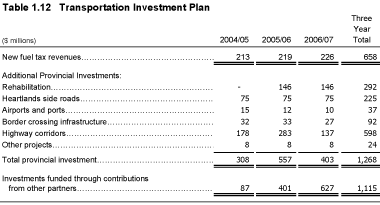
The updated transportation plan provides:
- $1,268 million of additional provincial investment in transportation infrastructure between 2004/05 and 2006/07; and
- $1,115 million of additional investment leveraged through federal cost-sharing and partnerships with private partners.
Planned provincial investment has increased since Budget 2003 to address a number of changed assumptions. In particular, the decision to advance the construction of a portion of the Sea-to-Sky project by having the province finance and build certain sections has increased the amount of provincial funding required for the transportation plan. These funds will be provided through borrowings $200 million higher than previously planned by the end of 2006/07. The overall plan continues to have no increase in debt levels by the completion of the transportation investment plan.
Projects currently being planned or constructed under the transportation plan include ongoing rehabilitation, investment in Heartlands side roads, improvements within the Kicking Horse Canyon and the Sea-to-Sky Highway.
As part of the BC Rail investment partnership, $200 million of proceeds will be made available to finance transportation infrastructure across British Columbia.
Further information on the transportation plan can be found on the Ministry of Transportation website at: www.gov.bc.ca/tran/.
Natural Resources
Forests
As part of the Forestry Revitalization Strategy, Budget 2004 will increase funding for the BC Timber Sales (BCTS) program by $176 million over the next three years. As a result, volumes of timber prepared and marketed through the program will increase from 13 per cent to 20 per cent of the total provincial annual allowable cut. This strategy will maximize the value from public forests by marketing Crown timber competitively, at auction, and will establish a credible reference point for costs and pricing of Crown forest resources.
Chart 1.14 BC Timber Sales Program
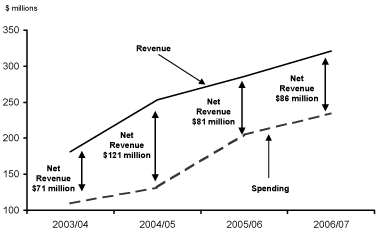
Over the next three years, $6 million will be invested to continue small-scale salvage opportunities and a further $6 million will be provided to increase harvesting of burnt and pine beetle-killed timber. Budget 2004 also includes funding to maintain some forest recreation sites and related roads.
Oil and Gas
Funding of over $12 million will be provided over the next three years for Oil and Gas Development Strategy projects to increase provincial oil and gas development. In addition, $17 million will be invested over the next three years to fund a dedicated offshore oil and gas team to investigate potential offshore development in BC in consultation with the federal government, First Nations, local communities and industry. Further information is provided in a topic box at the end of this chapter.
Crown Land
Crown land is a valuable resource, yet most Crown land is not recorded with an asset value on the government's books. Under a variety of government programs, Crown land is sometimes transferred or leased free of charge, or at rates below market value, to local governments, non-profit and other organizations to fulfill social and economic objectives.
Historically, when transfers or leases of Crown land have occurred at less than market value the equivalent financial cost to government or benefit to recipients has often not been recorded.
With the transition to full application of generally accepted accounting principles in 2004/05, the government will begin fully recognizing as non-cash revenue and expense the market value of Crown lands transferred or leased free of charge, or at rates below market value.
Due to the offsetting effect of both the non-cash revenue gain to government and the grant expense to beneficiaries, there is no effect on the government's summary accounts bottom line or debt.
To accommodate this change, there will be a significant increase to the budget of the Ministry of Sustainable Resource Management over the next three years. This largely reflects the estimated value of planned park transfers to the federal and local governments, as well as a large number of expiring tenure leases.
First Nations
Budget 2004 provides $120 million for forestry revenue sharing agreements over three years. Since September 2002, the Ministry of Forests has signed agreements with 29 First Nations to provide access to more than 7 million cubic metres of timber and to share forestry revenues of $39 million.
First Nations will also benefit from:
- the use of BC Rail investment partnership proceeds to create a BC Rail First Nations Benefit Trust (see the BC Rail investment partnership topic box at the end of this chapter);
- land transfers related to the 2010 Olympics and funding for an Aboriginal Sports Legacy Fund;
- potential finalization of current Agreements-in-Principle that could provide numerous benefits from ownership of, or access to, provincial resources which include forests, minerals and some 33,000 acres of land;
- more focused First Nations' accommodation strategies which include increased consultations and accommodations through provincial oil and gas development initiatives and Crown land development through Land and Water BC; and
- the newly signed Recognition and Reconciliation Protocol between government and the First Nations Summit.
In Budget 2004, the pilot economic measures program which provided ad hoc assistance and capacity building has been replaced by more focused accommodation strategies that establish long-term relationships with First Nations and ensure their participation in the economic prosperity of the province.
Government Operations
Budget 2004 includes initiatives consistent with government's goals of ensuring efficiency, accountability and best value for taxpayers in providing public services. These initiatives include the following:
- Corporate Online, to streamline the operations of the Corporate Registry in the Ministry of Finance by allowing the public to file forms electronically over the Internet.
- Ministry of Management Services:
–developing alternative service delivery initiatives with private sector partners to deliver services and information to both the public and government.
–working to provide or improve high-speed Internet access to British Columbians through the Communications Infrastructure (Digital Divide) Initiative.
–implementing a framework for ministries and other levels of government to work together in communities to deliver services and information in a more coordinated and effective manner.
–continuing to develop the government portal to provide enhanced information and services to the public.
- In partnership with the private sector, the Ministry of Provincial Revenue is undertaking a revenue management project to improve management and collection of amounts owed to government while improving customer service.
Further information is available in ministry service plans.
Taxpayer-supported Crown Corporation and Agency Expenses
Taxpayer-supported Crown corporations and agencies provide a number of services to the public. These agencies are primarily funded from ministry sources, but may also have outside sources of revenue. Some of the services provided by taxpayer-supported Crowns are highway construction (BC Transportation Financing Authority), property management (BC Buildings), property assessment, (B.C. Assessment Authority), social housing (BC Housing Management Commission), transit services (BC Transit), and legal services (Legal Services Society). Revenue and spending of taxpayer-supported Crown corporations are combined with CRF revenue and expenses in Tables 1.4 and 1.5. However, revenues and expenses for individual taxpayer-supported Crown corporations are detailed in Appendix Table A9.
The decrease in forecast spending for 2004/05 from the Budget 2003 fiscal plan is primarily due to a reduction in operating costs for the BC Transportation Financing Authority. The infusion of funds from the BC Rail investment partnership will reduce BCTFA's borrowing requirements in the near term, lowering debt service costs. The classification of transportation expenditures has also changed to reflect current procurement and investment strategies. This has resulted in the capitalization of certain costs that were previously anticipated to be expensed or financed by private sector parties.
SUCH sector expenses
The SUCH sector is comprised of the school districts; universities; colleges, university colleges, and institutes; and the health authorities and hospital societies. The government funds these organizations that in turn deliver education and health-care services to British Columbians on the government's behalf.
For some of these organizations, such as the school districts and health authorities, government transfers and fees cover most of their operating costs. For other organizations, such as universities and colleges, their operating costs are only partially funded from government, with the remaining revenues raised from outside sources.
When calculating total government spending, the transfers to the SUCH sector are deducted from CRF spending to avoid double counting and the SUCH expenses are added to the net amount. Therefore it is the SUCH expenses in excess of government transfers that impact total government spending. For 2004/05, this amount is forecast to be $2.5 billion. This amount will be offset by the SUCH sector's own source revenue in determining the bottom line impact of the SUCH sector. The topic box at the end of this chapter and Appendix Table A9 include these impacts.
Regional authority expenses
Ministry of Children and Family Development Governance Authorities – In Budget 2003, the Ministry of Children and Family Development (MCFD) anticipated transferring funding and authority for services in its Community
Living Services and Child and Family Development programs to new governance authorities by the end of 2004/05. The program transfers have been delayed until the authorities are able to fulfill their role based on readiness criteria developed by MCFD. For further details, see MCFD's service plan.
Revenue
Government revenue includes the combined revenues of the CRF, taxpayer-supported Crown corporations, the SUCH sector, and the net income of commercial Crown corporations. In 2004/05, revenue is forecast to be $30.4 billion, up 3.2 per cent from the updated forecast for 2003/04 (see Table 1.4).
Chart 1.15 Revenue Forecast
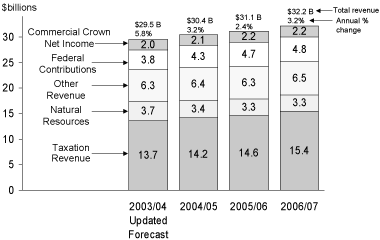
The 2004/05 forecast includes the effects of 4.6 per cent nominal GDP growth in 2004, higher taxation revenues, an increased Liquor Distribution Branch markup effective February 1, 2004 and BC Hydro's electricity rate application approved by the BC Utilities Commission on an interim basis, effective April 1, 2004. These effects are partially offset by lower forest revenue and lower federal transfer payments. In the next two years, revenue is forecast to grow 2.8 per cent per year on average as the economy posts an average 4.7 per cent annual nominal GDP growth.
The forecast does not include BC's estimated $260 million share of new Health Accord funding from the federal government's January 30, 2004 commitment to provide additional one-time funding of $2 billion to the provinces. Once specific details regarding amounts and timing of revenues are finalized, all of those funds will be added to the health care budget.
Key assumptions and sensitivities relating to revenue are provided in Appendix Table A10.
Taxation Revenue
In 2004/05, revenue from taxation sources is forecast to grow $516 million relative to 2003/04. Excluding a $157 million one-time gain in personal income tax revenue in 2003/04, overall taxation revenue in 2004/05 is forecast to be up 5.0 per cent and average 4.2 per cent growth over the next two years, reflecting expected growth in incomes and consumer spending.
- Personal income tax – an annual increase of $110 million in 2004/05. Excluding a one-time $157 million gain in 2003/04, growth of 5.6 per cent assumes the tax base increases 4.7 per cent. Over the next two years, revenue is forecast to increase an average 5.8 per cent reflecting forecast personal and labour income growth.
- Corporate income tax –an annual increase of $122 million in 2004/05, after a $49 million payment to the federal government for overpayments in 2003. The forecast assumes a 2004/05 instalment share of 8.74 per cent, up from 8.49 per cent in 2003/04. Revenue is expected to decline in 2005/06 mainly due to an assumed $112 million reimbursement to the federal government for overpayments received by BC in 2004. Revenue growth resumes in 2006/07 as instalments increase in line with national tax base growth. The forecast incorporates Budget 2004 measures to expand the base and qualifying activities under the International Financial Business Tax Refund Act and to extend the Scientific Research and Experimental Development (SRED) tax credit for five years.
- Social service tax – up 5.3 per cent in 2004/05 due to broadly-based increases in consumer purchases and business investment. Growth in sales tax revenue is forecast to average 4.6 per cent over the next two years, based on projected spending patterns in the Budget 2004 economic forecast.
- Property transfer tax – declining 14.5 per cent in 2004/05 as housing starts are expected to increase a relatively modest 3.0 per cent in 2004 and housing market activity moderates.
Natural Resource Revenue
- Energy – Revenue from natural gas, bonus bids, petroleum, minerals, and permits and fees is forecast to decrease $316 million or 14.8 per cent in 2004/05 mainly reflecting the assumption that 2004/05 will not see a repeat of the one-day $418 million bonus bid sale that occurred in September 2003. Over the next two years, revenue declines an average 6.0 per cent per year as natural gas and oil prices are expected to fall.
- Forests – In 2004/05, revenue is relatively unchanged from the updated 2003/04 forecast as the effects of increased harvest volumes are offset by a higher Canadian dollar and flat commodity prices. Thereafter, revenue rises slightly as an increasing proportion of timber is expected to be made available through the BC Timber Sales program. The forecast incorporates the decision to implement a market price system on the Coast, but assumes no resolution of the softwood lumber dispute and no further changes to stumpage policies.
Other Revenue
This category includes revenues from Medical Services Plan premiums, fees, licenses, investment earnings, sales of goods and services, fines and other miscellaneous sources. This includes revenue collected by ministries and treated as offsets to CRF spending, as well as revenue earned from outside the government entity by taxpayer-supported Crown corporations and agencies and the SUCH sector.
- Medical Service Plan premiums – at $1.4 billion, revenue is forecast to average 1.0 per cent growth over the three years, in line with population growth.
- Post-secondary fees – revenue collected by post secondary institutions (tuition, contract revenue, and fees for parking, incidental student activities and other various charges) is expected to average 8.1 per cent annual growth over the next three years.
- Other health-care related fees – expected to remain relatively flat over the three years at $425 million in 2006/07. This source includes charges for residential care, accommodation, inspection, community programs, activities, rentals and various other fees.
- Other fees and licences – includes the effect of providing free Crown grants and nominal rent tenures to establish new parks, transfer provincial parks to local government, and other land transfers. This reflects a non-cash transaction that records the write-up of land from book value to market value as increased revenue, but has no effect on government's bottom line as there is an offsetting expense. Excluding these land transfers, revenue is forecast to average 1.7 per cent annual decline over the three-year plan.
- Investment earnings – declining $82 million in 2004/05 due to lower sinking fund balances and lower cost recoveries from commercial Crown corporations. Revenue is forecast to grow an average 5.3 per cent over the next two years mainly due to the forecast of rising interest rates in 2005/06 and 2006/07. Recoveries from commercial Crown corporations have no effect on government's bottom line as there is an offsetting interest expense.
- Miscellaneous – $1.1 billion forecast in 2004/05, including $0.4 billion collected by government ministries, $0.1 billion from taxpayer supported Crowns and the remaining $0.6 billion from the SUCH sector. Overall revenue in this category is forecast to fall by an average of 3.0 cent per year over the next two years.
Contributions from the Federal Government
Federal government payments received under health and social transfer and equalization programs are the major sources of transfer payments. Other sources include payments from the federal government for health, education, social, transportation and other cost-shared programs. This includes federal transfers to ministries that are treated as offsets to spending and payments received by taxpayer-supported Crown corporations and agencies and the SUCH sector.
- Federal government health and social transfers –
In April 2004, the Canada Health and Social Transfer (CHST) program
will be split into two separate funding programs, the Canada Health
Transfer (CHT) and the Canada Social Transfer (CST). Two other
federal programs included are the Early Learning and Child Care
(ELCC) program and the Health Reform Fund (HRF). In addition,
the forecast includes deferred revenue from the Diagnostic/Medical
Equipment Trust and the 2003 CHST Supplement Trust established
by the federal government in its February 2003 plan.
Details are shown in Appendix Table A10. In the 2004/05 to
2006/07 period, entitlements are expected to grow in line with
increases previously announced by the federal government and BC's
share of national population.
The forecast does not include BC's estimated $260 million share of new Health Accord funding from the federal government's January 30, 2004 commitment to provide additional one-time funding of $2 billion to the provinces. Once specific details regarding amounts and timing of revenue are finalized, all of those funds will be added to the health care budget.
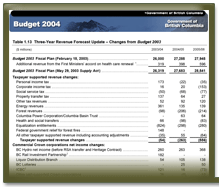 |
Table 1.13 Three-Year Revenue Forecast Update – Changes from Budget 2003 | ||
- Equalization – forecast at $402 million in 2004/05, essentially the same as BC's $400 million 2003/04 entitlement. Equalization revenue is forecast to increase slightly in 2005/06 and 2006/07, as the gap between BC's and Canada's nominal GDP per capita stabilizes. The forecast for this source is volatile due to the risk of historical revisions and the complex formula. Depending on circumstances, changes to the equalization transfers may be partially offset by CHT and CST payments. The forecast does not assume any changes to the current set of federal regulations when the equalization formula is renewed in 2004/05.
Compared to the Budget 2003 plan, overall taxpayer-supported revenue is forecast to be $54 million lower in 2003/04, down $263 million in 2004/05 and $556 million lower in 2006/07. The main areas of change are:
- Personal income tax – up $173 million in 2003/04 due to higher-than-expected tax assessments for the 2002 tax year and essentially no change in the next two years.
- Social service tax – down $50 million in 2003/04 due to lower-than-expected collections, especially in the first half of the year. The change is $77 million lower by 2005/06 reflecting lower taxable expenditure growth.
- Other taxes – up $52 million, $92 million and $120 million over the 2003/04 to 2005/06 period. The additional higher revenue is mainly due to increasing property, fuel and other tax revenues. The additional $40 million tobacco tax revenue due to rate increases effective December 20, 2003 is also part of the increase from the Budget 2003 plan.
- Energy – The overall forecast from all energy sources is up from the Budget 2003 plan as assumed increased exploration activity and bonus bid revenue, due in part to government initiatives to promote natural gas exploration and development, is expected to lead to higher natural gas production. In addition, the Budget 2004 forecast assumes energy prices do not decline as quickly over the next two years.
- Forests – down $98 million in 2003/04 reflecting a higher Canadian dollar and lower harvest volumes. Revenue is more than $200 million lower than the Budget 2003 plan in the next two years due to the effects of a higher Canadian dollar and assumed lower effective rates in the BC Timber sales program.
- Equalization – down $824 million in 2003/04 reflecting a $275 million lower entitlement in respect of 2003/04 and a negative $549 million prior year adjustment, mainly for 2002/03. BC's estimated equalization entitlement is between $275 million and $300 million lower than the Budget 2003 forecast in each year of the three year plan due to the lower entitlement for 2003/04.
Commercial Crown Corporation and Agency Net Income
- British Columbia Hydro and Power Authority – forecasts $388 million in income before deferral transfers for 2004/05. The forecast includes the impact of the 7.23 per cent interim rate increase approved by the BC Utilities Commission that is effective April 1, 2004. The 2004/05 forecast represents a $263 million improvement to BC Hydro's projection in the Budget 2003 fiscal plan. The improvement reflects both the rate increase and a reduction in debt servicing costs due to lower interest rates and debt levels. This is partly offset by the impact of lower projected water inflows, which are expected to be 94% of normal (based on the January 01, 2004 snowpack levels). The projection in last year's fiscal plan assumed normal water inflows.
- British Columbia Liquor Distribution Branch (LDB) – at $760 million, LDB's projected net income for 2004/05 is $105 million higher than the projection in the Budget 2003 fiscal plan. Total liquor sale revenue is forecast to be an average 6.7 per cent higher than previously forecast, reflecting both the increase in mark-up rates and higher volumes. At the same time, LDB forecasts a reduction in commissions due to the government retaining its retail operations. Increased operating costs will be offset by the elimination of projected transition costs.
- British Columbia Lottery Corporation – BC Lotteries
projects net income of $850 million for 2004/05, a $25 million
improvement over the Budget 2003 forecast. The lottery
revenue forecast has been reduced to reflect more recent sales
trends. This is offset by increases in gaming and bingo revenue,
reflecting the proposed introduction of 300 slot machines at the
Hastings Park racetrack facility and upgrades to bingo facilities.
BC Lotteries' impact on the fiscal plan is less than its net income due to the distribution of gaming revenue to third parties. For 2004/05, the government forecasts that it will distribute $218 million of gaming revenue to third parties - $133 million to charities, $66 million to local governments, and $11 million for illegal gaming enforcement and horseracing purse enhancement. As well, $8 million will be paid to the federal government. The fiscal plan impact after distribution will be $632 million, of which $147 million is allocated to the Health Special Account and $485 million will go into general revenue.
- British Columbia Railway Company – BC Rail's
forecast for 2004 includes the $182 million net impact of
the investment partnership and debt defeasance announced in November 2003.
As the partnership is assumed to be complete before March 31, 2004,
the government is forecasting that the impact will be included
with its 2003/04 financial statements. More information on the
investment partnership can be found in the topic box at the end
of this chapter.
Excluding the impact of the investment partnership and debt defeasance, BC Rail forecasts net income of $29 million in 2004, based on full-year projections for its real estate and marine divisions, and the operation of its rail freight division until March 2004. The $29 million forecast for 2004 is unchanged from the net income forecast for the same year in the Budget 2003 fiscal plan.
- Insurance Corporation of British Columbia (ICBC) – At $52 million, ICBC's 2004 projected net income represents a $16 million improvement over the 2004 projection in last year's fiscal plan. The improvement is primarily due to higher premium revenue and lower operating costs, partially offset by higher claims costs.
Full-Time Equivalents (FTEs)
Taxpayer-supported FTEs, including ministries and special offices (CRF), taxpayer-supported Crown corporations and agencies and regional authorities, is projected at 31,100 in 2004/05. This represents a decline of 2,280 FTEs from the 2003/04 forecast and is 160 FTEs lower than the 2004/05 forecast in last year's fiscal plan.
By 2006/07, FTEs are projected to decline a further 325 to total 30,775 FTEs. Table 1.15 provides details of changes from last year's plan. FTEs of the SUCH sector are not included in these forecasts.
Ministries and special offices (CRF)
Total FTEs for ministries and special offices are projected to decline by 1,590 in 2004/05, consistent with ministry service plans for 2004/05 – 2006/07. The decline is 3,293 FTEs lower than the Budget 2003 forecast reflecting priorities in a number of areas.
Approximately 2,800 FTEs within the Ministry of Children and Family Development were planned to be transferred to new governance authorities by 2004/05. These transfers have been temporarily delayed until the authorities are able to fulfill their role based on readiness criteria developed by the Ministry of Children and Family Development. An additional 95 FTEs were added to ministry's allocation on completion of a mid-term service plan review. Further information is available in the ministry's service plan.
Other FTE changes in Budget 2004 reflect a number of government economic development priorities such as expanded programs for BC Timber Sales and oil and gas strategies.
The three-year plan presented in Budget 2002 assumed that the overall FTE budget for ministries and special offices would be reduced by 11,813 FTEs over the period 2001/02 to 2004/05. The updated forecast for 2004/05 show a cumulative reduction of 7,886 FTEs.
Most of the change since the Budget 2002 forecast reflects the temporary delay in establishing the Children and Family Development governance authorities as well as a mid-term service plan review of the ministry. Other changes reflect the assumption of staff from ICBC in Budget 2003 and the various priorities in Budget 2004 noted earlier.
Table 1.14 provides a summary of Ministry and Offices FTE changes since Budget 2002.
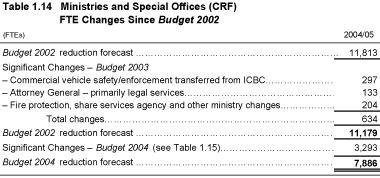
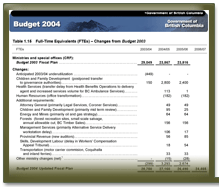 |
Table 1.15 Full-Time Equivalents (FTEs) – Changes From Budget 2003 | ||
Taxpayer-supported Crown corporations and agencies
The 2004/05 taxpayer-supported Crown corporation and agency FTE projection is 3,940, a reduction of 653 FTEs from last year's fiscal plan. The reduction is primarily due to:
- the exclusion of FTEs in the Forensic Psychiatric Services Commission as this organization is part of the SUCH sector which is not included in the FTE table (362 FTE reduction);
- an outsourcing initiative by the BC Buildings Corporation (317 FTE reduction); and
- an increase to the BC Pavilion Corporation's convention centre marketing services for the expanded facility being constructed in Vancouver.
Capital Spending
Capital spending1 is needed to replace ageing infrastructure and to meet the needs of a changing population. Financing for the building of schools, hospitals, long-term care facilities, roads, dams and other forms of provincial infrastructure is largely met through borrowed funds and is a major component of provincial debt.
|
|
|
| 1 | Capital spending is not included in the government's annual surplus or deficit. In accordance with generally accepted accounting principles (GAAP), annual amortization expenses that recognize the estimated wear and tear of capital assets during the fiscal year are included in the government's annual expenses instead of recording the full capital costs as they occur. |
In each of the next three fiscal years, combined annual capital spending of the provincial government, the SUCH sector, and taxpayer-supported and commercial Crown corporations and agencies will average $2.9 billion.
Although total expenditures will be relatively unchanged, taxpayer-supported capital spending will decline from $1.9 billion in 2004/05 to $1.6 billion in 2006/07. The decrease reflects completed projects and the impact of P3s on capital spending costs.
Self-supported capital spending will increase from $1 billion in 2004/05 to $1.3 billion in 2006/07 reflecting BC Hydro and BC Transmission projects to enhance the province's power generation and transmission systems.
Further details on capital spending over the next three years are shown in the service plans of ministries and Crown corporations.
As required under the Budget Transparency and Accountability Act, major capital projects with multi-year budgets totaling $50 million or more are shown in Table 1.17. Annual allocations of the full budget for these projects are included as part of the provincial government's capital spending shown in Table 1.16.
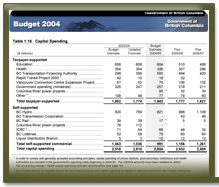 |
Table 1.16 Capital Spending | ||
Over the next three years $1.2 billion of provincial funding will be spent on major capital projects (greater than $50 million) including:
- $195 million for major transportation capital projects. In addition, the Ministry of Transportation is investigating financial and project delivery options through P3s for improvements to Lower Mainland infrastructure, including expansion of the Port Mann Bridge; the Okanagan Lake Bridge in Kelowna; and the Trans Canada Highway in the Kicking Horse Canyon.
- $71 million for the Vancouver General Hospital and $33 million to complete the UBC Life Sciences Centre project.
- $628 million for power generation capital projects by BC Hydro and the Brilliant Expansion Power Corporation. Included in this amount are the Vancouver Island generation project and the Georgia Strait pipeline crossing, although a Call-for-Tender process is underway to solicit proposals from the private sector for supplying Vancouver Island with additional power.
- $238 million for other projects including the Vancouver Convention Centre Expansion Project and tenant improvements for Surrey Central City.
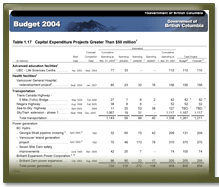 |
Table 1.17 Capital Expenditure Projects Greater Than $50 Million | ||
Table 1.17 identifies the provincial share of funding for major capital projects (over $50 million). However, total costs for some of these projects are higher as they are cost-shared with the federal government, municipal authorities and the private sector.
Provincial Debt
In 2003/04, provincial debt is forecast to increase by $915 million to total $37.8 billion, $3.6 billion below budget. In 2004/05, provincial debt will increase $1.6 billion from the 2003/04 updated forecast to total $39.5 billion. The 2004/05 change reflects:
- a $1.6 billion increase in taxpayer-supported debt to finance operating and net capital requirements, and the reclassification of Columbia River power projects debt to the taxpayer-supported category;
- an $81 million decrease in commercial Crown corporation debt, mainly due to the reclassification of Columbia River power projects debt ($215 million), partially offset by increased borrowing for BC Hydro; and
- a $100 million forecast allowance to mirror the income statement forecast allowance.
Over the following two years, taxpayer-supported debt will increase $655 million reflecting the annual capital requirements under the fiscal plan. Self-supported debt will increase $471 million, mainly to fund BC Hydro's capital program.
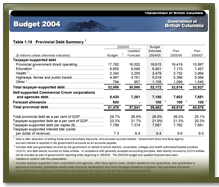 |
Table 1.18 Provincial Debt Summary | ||
The debt forecast assumes a borrowing allowance of $100 million to mirror the operating statement forecast allowance. This has the effect of raising the debt forecast by $100 million in 2004/05 and each subsequent year. However, should the government not require this allowance, projected debt levels under the fiscal plan would be $100 million lower for 2004/05 and thereafter.
The ratio of taxpayer-supported debt, which excludes commercial Crown corporations and other self-supported debt, to GDP is a key measure often used by financial analysts and investors to assess a province's ability to repay debt. In 2004/05 taxpayer-supported debt is forecast to increase to 21.9 per cent of GDP before declining to 21.3 per cent of GDP in 2005/06 and 20.3 per cent of GDP in 2006/07. The change from the Budget 2003 forecast reflects a $2 billion improvement in taxpayer-supported debt in 2003/04 and higher GDP forecasts. Taxpayer-supported interest costs are expected to remain stable at just over six cents per dollar of revenue over the three-year period.
Table 1.19 summarizes the provincial financing plan for 2004/05. New borrowing of $4.6 billion is anticipated, of which $3 billion will be used to replace maturing debt and $1.6 billion to finance capital and operating requirements.
Further details on the debt outstanding for government, Crown corporations and agencies are provided in Appendix Tables A14 and A15.
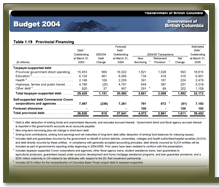 |
Table 1.19 Provincial Financing | ||
Risks to the Fiscal Plan
The risks to the fiscal plan stem mainly from changes in factors that government does not directly control. These include:
- Assumptions underlying revenue and Crown Corporation and agency forecasts such as economic and population growth, commodity prices and weather conditions.
- The outcome of litigation, arbitrations, and negotiations with third parties, such as the softwood lumber dispute.
- Utilization rates for government services such as health care or employment assistance.
In addition, changes in accounting treatment or revised interpretations of GAAP could have significant impacts on the bottom line.
Table 1.20 summarizes the average bottom-line effect of changes in some of the key variables. However, individual circumstances and inter-relationships between the variables may cause the actual variances to be higher or lower than the estimates shown in the table. For example, a decrease in equalization payments may be offset by an increase in commercial Crown corporation incomes; or as occurred in 2003/04, an increase in the US exchange rate can be largely offset by higher commodity prices.
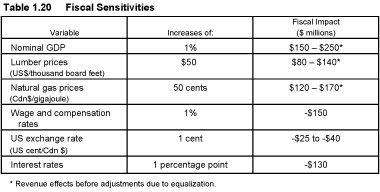
The experience of the 2003/04 fiscal year also demonstrates the tendency for negative fiscal shocks – forest fires, floods, BSE, equalization revenue losses – to be offset by positive variances in other areas – Commercial crown corporation incomes, taxation and energy revenues, and other improvements. Despite the volatility in 2003/04, the $500 million forecast allowance has not been needed and in fact has been reduced to $100 million in the updated forecast.
Forecast Allowance and other contingency provisions.
In 2004/05, the government continues to build a forecast allowance into the bottom-line to act as a cushion against possible deterioration in revenue forecasts, and thus increase the likelihood of meeting the balanced budget target established in the fiscal plan.
A forecast allowance of $100 million is included in the 2004/05 budget. This forecast allowance reduces the expected surplus from the government's most likely forecast of $200 million in 2004/05 to a more conservative budget surplus of $100 million.
Over and above the $100 million budget surplus and the $100 million forecast allowance, the 2004/05 budget includes a $240 million contingency vote for unexpected spending requirements or opportunities by government ministries. Combined, these provide a $440 million cushion to protect the balanced budget plan against unforeseen events in 2004/05.
A corresponding $100 million borrowing allowance has also been included in the provincial debt forecast for 2004/05, increasing the total debt forecast by $100 million compared to the most likely forecast.
Forecast allowances are not included in the fiscal plan for the 2005/06 and 2006/07 years. The government will incorporate annual forecast allowances in the budgets for those years based on a risk assessment at that time. However, a $240 million contingency vote is included in each of 2005/06 and 2006/07. Combined with the forecast surpluses, the total cushion protecting the balanced budget against economic, revenue and other forecast shocks is $515 million in 2005/06. This increases to $540 million in 2006/07.
SUCH Sector
SUCH sector forecasts have been provided by management of the various organizations based on broad policy assumptions provided by the Ministries of Health Services, Advanced Education and Education. Every effort has been made to ensure that the financial information is compiled in a manner consistent with GAAP. However due to the timing of the budget, SUCH sector organizations submitted their forecasts before final review and approval of these forecasts and the underlying assumptions by their respective boards. Final approved plans may therefore differ from the management forecasts included in the budget.
Revenue
The revenue forecast contained in the fiscal plan is based on the economic forecast detailed in Part 3: British Columbia Economic Review and Outlook. Details on major assumptions and sensitivities resulting from changes to those assumptions are shown in Appendix Table A10.
The main areas that may affect the revenue forecast are:
- B.C.'s overall economic performance;
- exchange rate and commodity prices, especially natural gas, lumber and electricity;
- the outcome of the softwood lumber dispute with the U.S.;
- final determination of the rate application by BC Hydro;
- water levels in the BC Hydro system;
- fluctuations in BC's equalization entitlement due to new information, including changes in the fiscal capacity of Ontario and Quebec; and
- changes to the federal government formula for calculating equalization entitlements.
Equalization revenue estimates are subject to large fluctuations. For example, the federal government estimates received in October 2003 showed a reduction from their February 2003 estimates of over $300 million in each of 2002/03 and 2003/04. New federal estimates that may also be volatile will be received in February 2004. In addition, changes to equalization revenues can be expected as the federal government defines the formula to be used over the next five years. Formula changes could have significant effects on forecast equalization entitlements, as some options being considered by the federal government could eliminate BC's equalization entitlements entirely.
Crown corporations and agencies have provided their own forecasts that were used to prepare the fiscal plan, as well as their statements of assumptions. The boards of those corporations and agencies have included these forecasts, along with further details on assumptions and risks, in the service plans being released with the budget.
The fiscal plan does not assume or make allowance for extraordinary adjustments other than those noted in the assumptions provided by the Crown corporations and agencies. Factors such as electricity prices, water inflows into the BC Hydro system, accident trends, interest/exchange rates, decisions of an independent regulator, or pending litigation could significantly change actual financial results over the forecast period. In particular, the final ruling by the BC Utilities Commission on BC Hydro's rate application could differ from their interim approval that was used as the budget assumption.
A further risk to Crown corporation net incomes is the possibility of delays in BC Lotteries implementation plans. In addition, as noted in the topic box on the BC Rail Investment Partnership, the timing of the Competition Bureau's review determines the fiscal year in which the transaction will be booked for accounting purposes. The fiscal plan assumes this will occur prior to March 31, 2004. However, there would be no impact on the bottom line from a delay into the 2004/05 fiscal year, as the timing of related reinvestments is linked to the date of completion. There would however be a change to the debt levels at March 31, 2004, since the planned debt reduction would not occur until 2004/05.
New decisions or directions by Crown corporation or agency boards of directors may result in changes to costs and revenues due to restructuring, valuation allowances and asset write-downs, or gains and losses on disposals of businesses or assets.
In situations where revenue could benefit as a result of a negotiated or litigated settlement, no revenue increases have been assumed except where a detailed agreement-in-principle has been reached, as in the BC Rail Investment Partnership. Specifically no assumptions have been made as to potential benefits from various outstanding liabilities owing to BC Hydro, or potential resolution of the softwood lumber dispute with the US. Additionally, due to uncertainty as to the precise conditions and accounting treatment of the estimated $260 million share of the additional $2 billion Health Accord funds announced on January 30, 2004, these additional federal transfers have not been included in Budget 2004.
Spending
The spending forecast contained in the fiscal plan is based on ministry and taxpayer-supported Crown corporation and agency spending plans and strategies, as well as SUCH sector forecasts. Details on major assumptions and sensitivities resulting from changes to those assumptions are shown in Appendix Table A11 and in ministry service plans. The main spending issues follow.
Compensation
Between March 31, 2003 and March 31, 2006 virtually all public sector collective agreements either expired or will soon expire. The Working Agreement with the British Columbia Medical Association also expires during this period.
With an annual compensation bill of about $15 billion for taxpayer supported entities, and an additional $1.1 billion in commercial Crown corporations, a hypothetical 1 per cent increase in each of the next three years would increase taxpayer-supported spending by $150 million in 2004/05, $300 million in 2005/06 and $450 million or more in 2006/07. Within a balanced budget environment, the effect of such a raise would require government to reduce program funding or raise taxes.
That is why the mandate for new negotiations has been confirmed as being 0 per cent/0 per cent for the 2004/05 to 2005/06 period, reconfirming the government's bargaining mandate for 2003/04 through 2005/06 of 0 per cent/0 per cent/0 per cent. Public sector employers may address legitimate skills shortages through market adjustment increases; however the government has not provided incremental funding to employers for market adjustment increases.
This mandate recognizes that public sector wages are among the highest in the country. After the last round, health care professionals and physicians received significant increases that provide this key sector with competitive wage and salary rates. Government believes the current mandate to be both realistic and reflective of market conditions, and consistent with the province's desire to ensure BC retains the professionals needed to deliver quality health care and other services. Twenty seven agreements have been concluded under this mandate including a settlement with the BC Government and Service Employees' Union, the second largest public sector union, and others within the post secondary education sector, with midwives, and within Crown corporations.
Demand-driven Programs
The government funds a number of demand-driven programs such as Pharmacare, K-12 education, student financial assistance and income assistance. The budgets for these programs reflect the best estimate of demand and other factors such as price inflation. If demand is higher than estimated, this will result in a spending pressure to be managed.
Public Sector Program Delivery
The vast majority of government funded services are delivered through third party delivery agencies that provide programs such as acute and continuing health care, K-12 education, post-secondary education, and community social services. All of these sectors face cost pressures in the form of program demand and non-wage inflation.
The provincial government has implemented legislative changes to provide public sector delivery agencies with greater flexibility to determine how they will deliver services. The lower cost structure made possible by the legislative changes and upcoming accountability contracts with public sector delivery agencies is reflected in this plan. If public sector delivery agencies are unable to achieve the estimated savings, budgetary pressures could arise.
Treaty Negotiations
The government is committed to negotiating affordable, working treaties with First Nations that provide certainty regarding ownership and use of provincial Crown land and resources. The province has recently concluded, or is near conclusion of, Agreements-in-Principle with the Lheidli T'enneh, Maa-nulth, Sliammon, Snuneymuxw and Tsawwassen First Nations. The province will focus resources on key opportunities in order to reach final settlements with these and other First Nations and Canada over the next two to three years. Outcomes of negotiations could affect both the economic outlook and the fiscal plan.
Catastrophes and Disasters
The spending plans for the Ministries of Forests; Public Safety and Solicitor General; and Water, Land and Air Protection include amounts to fight forest fires and deal with other emergencies such as floods and blizzards. These amounts are based on historical averages of actual spending and on conditions of normal to moderate severity. Abnormal occurrences, as occurred in 2003/04, may affect expenses in these ministries and those of other ministries.
Pending Litigation
The spending plan for the Ministry of Attorney General contains provisions for payments under the Crown Proceeding Act based on estimates of expected claims and related costs of settlements likely to be incurred. These estimates are based on a historical ten-year average of actual spending. Litigation developments may occur that are beyond the assumptions used in the plan (for example, higher-than-expected volumes, or size of claim amounts and timing of settlements). Various legal actions may also establish precedents requiring minimum service levels in various areas of provincial jurisdiction. These developments may also affect expenditures in other ministries.
One-time Write-downs and Other Adjustments
Ministry budgets provide for normal levels of asset or loan write-downs. The overall spending forecast does not make allowance for extraordinary items other than the amount provided in the contingencies vote.
Unfunded Liabilities
The College, Public Service, Teachers and Municipal Pension Plans – the four major public service plans - are joint trusteeship plans. In the event that a plan deficit is determined by an actuarial evaluation, the pension boards are required to address it by contribution adjustments or other means. Any unfunded liabilities are therefore expected to be short term in nature. For example, the most recent actuarial valuation of the Teachers' Pension Plan indicated a $382 million liability, which will be addressed by an increase to contribution rates of 0.55 per cent effective July 1, 2004.
The Healthcare Benefits Trust, established to provide health and welfare benefits to certain health sector and social service sector employees, has an estimated unfunded liability of $260 million as of March 31, 2004. The updated forecast for 2003/04 includes a $51 million expense to the regional Health Authorities and a $12 million expense in the Ministries of Health Services and Children and Family Development. The remaining liability is assumed to be charged as a prior year adjustment.
Capital Risks
The capital spending forecasts assumed in the fiscal plan may be affected by various factors including:
- weather and geotechnical conditions causing project delays or unusual costs;
- changes in market conditions, including service demand, inflation, borrowing costs and wage settlements;
- the outcome of environmental impact studies;
- cost-sharing agreements with other jurisdictions; and
- the success of public-private sector partnership negotiations.
Contingencies
The fiscal plan includes a CRF contingencies vote of $240 million for each of the 2004/05, 2005/06 and 2006/07 fiscal years, to help offset unforeseen spending pressures. For budget planning purposes, these votes are assumed to be fully spent.
 |
||||
